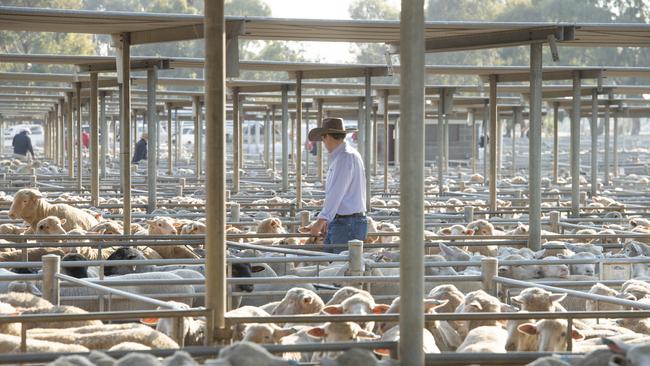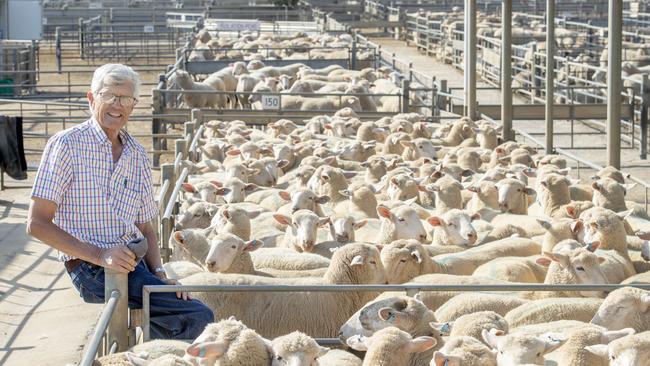Weather: Farmers nervous wait for the autumn break
With just over a week till the traditional Anzac Day autumn break, farmers are feeling nervous as livestock markets are flooded with stock amid a dismal weather forecast.

Farmers across southeast Australia are on edge as livestock markets are flooded amid a dismal weather forecast and stagnant prices.
With April 25 — considered by many farmers to be the ideal date for an autumn break — looming, producers are re-assessing their options with minimal rain on the horizon for much of Victoria, southern NSW and South Australia.
In the past week, saleyards have become awash with prime and store cattle as producers – feeling uncertain about where prices are heading, the number of stock being held in paddocks and the season ahead – opt to take the money, rather than risk feeding through winter for uncertain returns.
Last week, Echuca yarded 15,500 cattle – its biggest prime market in more than a decade – and at Hamilton, 14,000 sheep were penned, double the week prior. At Wagga Wagga in southern NSW on Monday, 5900 prime cattle were yarded, an increase of 1300 on the previous week while the Mortlake store sale on Thursday is expected to pen 6000 cattle.
In Tasmania, where rain is still badly needed, 4000 weaner calves will look for strong northern interest in the last of the big young cattle sales of the season, scheduled for Powranna.
Gippsland agent Anthony Delaney said the beef industry was in another wave of selling.
“There is cattle everywhere at the moment,’’ Mr Delaney said.
“People that had held onto cattle are now chasing the market for that bit better money which is now on offer, particularly as we’re on the cusp of winter.’’
Figures from the Bureau of Meteorology reveal swathes of Victoria have recorded minimal rain since the start of autumn. Bendigo has measured just 5mm since the start of March with Mildura picking up just 10mm, Ouyen and Warracknabeal 16mm, Hamilton 17mm and Casterton 18mm.
North East Victorian agent Gordon Perkins, from Corcoran Parker at Wodonga, said many producers were still uneasy about the beef market after a rollercoaster ride in recent months that hit very low price points.
“People with spring-drop calves in the 250-300kg range are saying we will take the $1000 to $1200, as it is either that or wear the cost of feeding hay through the winter and not knowing what they will be worth at the other end.’’
Yea livestock breeder Olivia Lawson likened trying to read the current cattle market to “reading tea leaves”. The patchy seasonal conditions were impacting many of her Paringa stud clients throughout Australia, Ms Lawson said.
The benchmark Eastern Young Cattle Indicator lost 13c/kg in the week to Tuesday morning, to sit at 608c/kg carcass weight, while trade lambs moved 16c/kg lower to average 637c/kg.
Light lambs lost ground swiftly on Monday as news broke that air-freighted lamb exports were being flown back to Australia, as Iran’s attack on Israel shut down flights into the Middle East.
The National Livestock Reporting Service quoted light lambs as 22c/kg cheaper in the past week, to average 551c/kg.
Cattle prices have slipped on all categories, from heavy steers and cows down to restocking yearlings; all lost 5c to 10c/kg in the past week.
Warrnambool dairy farmer and United Dairyfarmers of Victoria president Bernie Free said the autumn break was patchy and “definitely not widespread”.
“The long-range forecasts are saying we won’t have rain until early to mid May, and it takes six weeks at least to grow a feed wedge (of grass),” Mr Free said.
“I’d anticipate many of us could need to feed stock until the end of July.”
Sheep and cropping producer David Less from Diggora near Rochester said with 32mm of rain in the past fortnight, the autumn break had arrived for him.
“We had 5.5 inches in January which set the lucerne up nicely, it became very dry in March and it had run its race a bit,” he said.
“But with the recent rain it is now coming back”.

Meanwhile on the cropping front, significant rainfall in northern NSW and Queensland has seen grain prices increase by up to $20 a tonne.
Some Queensland farmers have measured as much as 300mm in the rain gauge in the past fortnight.
There was also an uptick in prices offshore, which affected the Australian domestic market.
Wheat is trending at $341 a tonne at Victorian ports, with canola commanding $657 a tonne and lentils at $955 a tonne.
The upsurge in canola has come as welcome news for growers who rely on the oilseed crop for their rotations. A month ago, canola had dipped below the benchmark of $600 a tonne.




